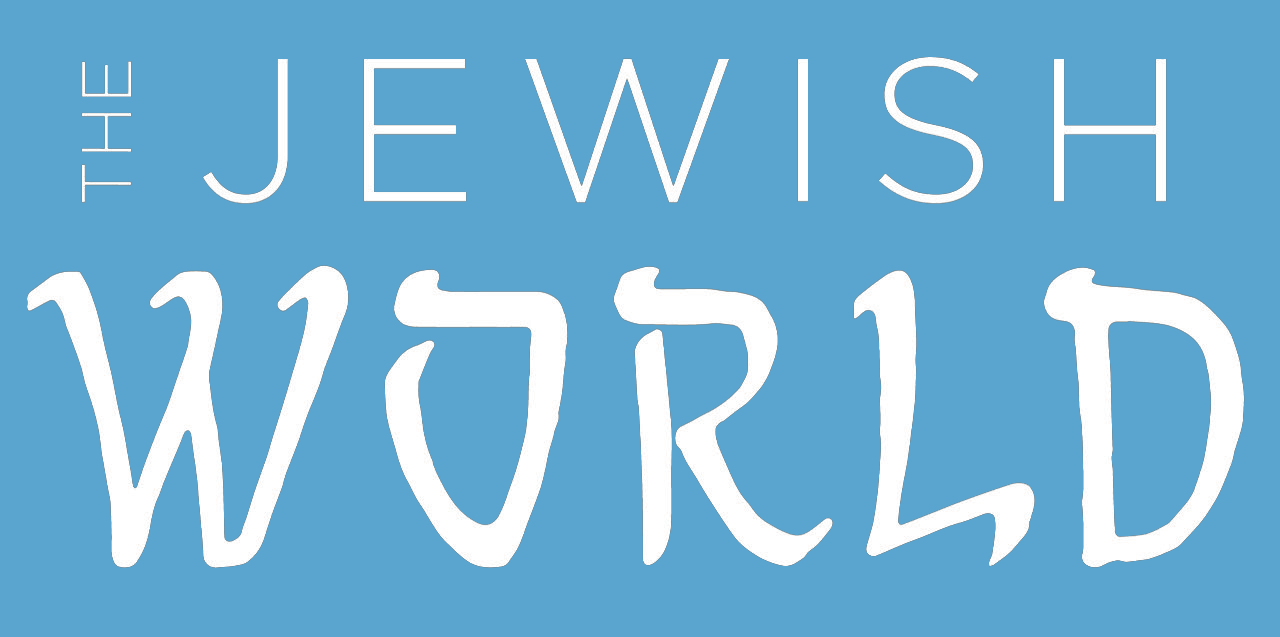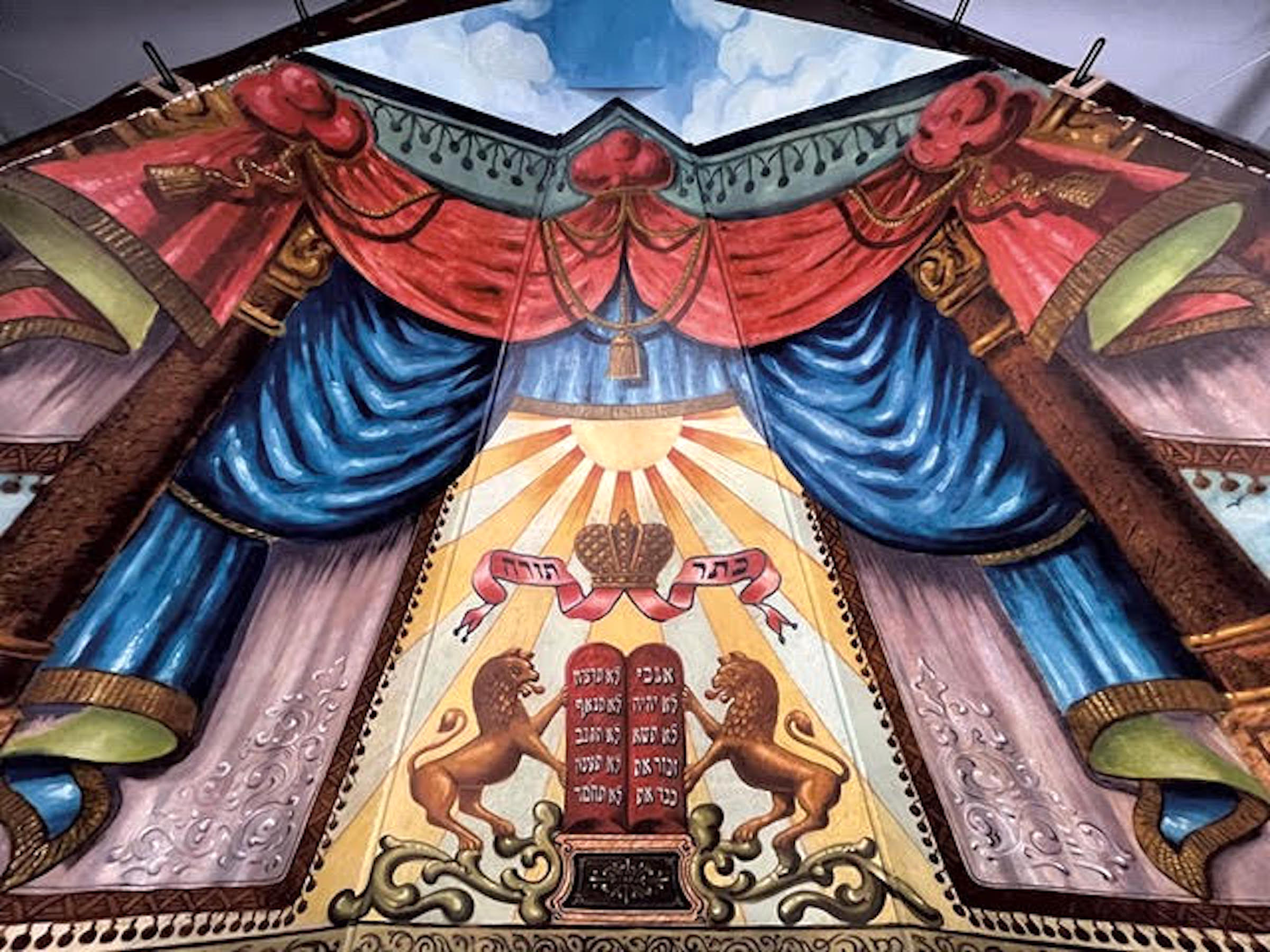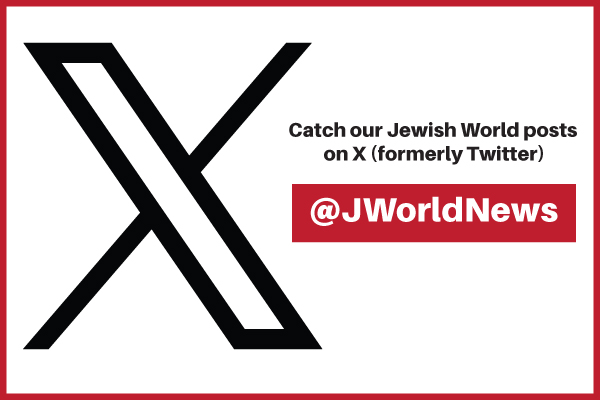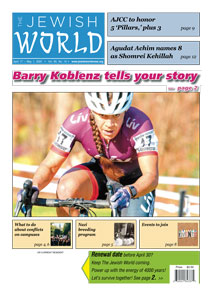By MARILYN SHAPIRO
My father, the late Bill Cohen loved to play Jewish geography, and he proudly shared with us how the first synagogue in Burlington Vt. was founded in his grandfather’s kitchen. As we lived on the New York side of Lake Champlain, we often visited many aunts, uncles, and cousins who lived in the Queen City and the surrounding areas. One was Uncle Paul Pearl (nee Pesach Ossovitz), who learned the peddling trade from his uncle Archic Perelman and went on to oversee 27 Pearl’s department stores in Upstate New York and Vermont. And then there were Uncle Moe Pearl, who owned several businesses in the area, and his wife Bess; Ruth (Pearl) Kropsky and her husband Isidore; and Aunt Ida and her husband Max Ahrens.
When the Pels family, my Burlington cousins, attend the High Holy Day services for the year 5783, Congregation Ohavi Zedek will have a welcome new addition: the restored “Lost Mural” in the foyer, completed in June 2022 by the Lost Mural Project. Since the story starts in part with my great-grandfather Isaac Perelman, a founding member of this Burlington synagogue, I am happy to share it with you.
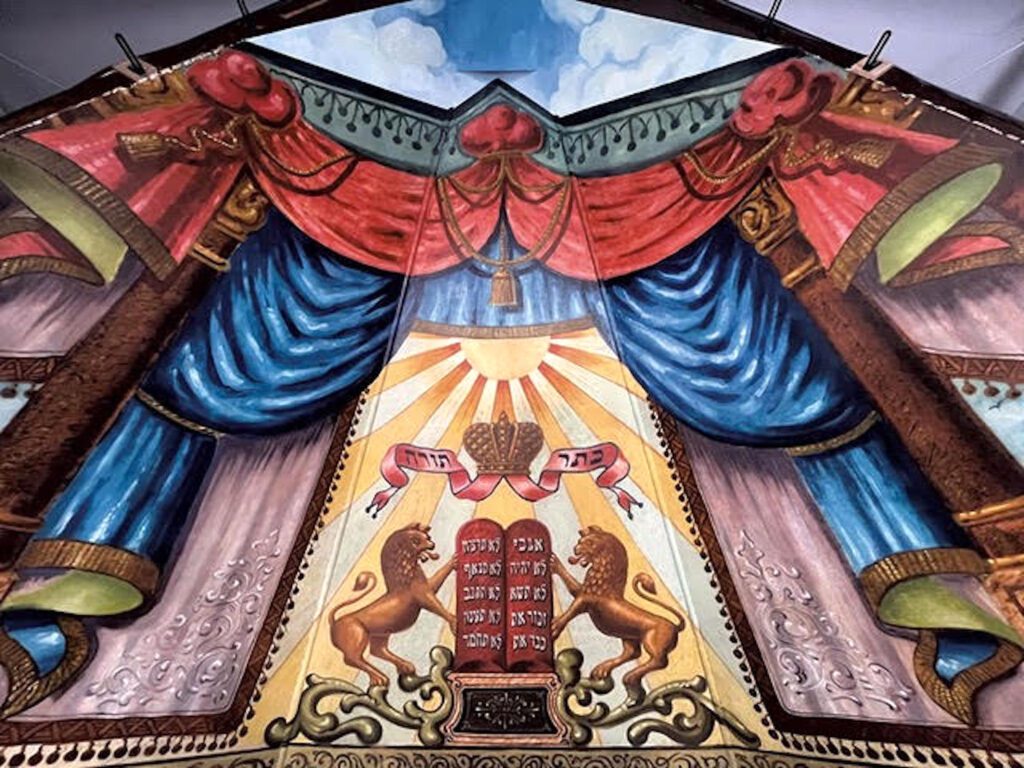
The mural. Photo courtesy of the Lost Mural Project
Congregation Of Peddlers
Although Jews had settled in Burlington as early as 1848, the 1880s saw an influx of Eastern European Jews who had been facing persecution in all phases of their personal, professional and religious lives. One of the early settlers was my great -grandfather, Isaac “Itsak” Perelman, who came from Čekiškė, Lithuania. Others came from New York City to escape work in the sweatshops; a few migrated from Plattsburgh, N.Y., as it didn’t have an Orthodox shul.
Most of the refugees became peddlers in northern Vermont, selling their wares from horse or man-drawn carts.
Initially, a group of 10 Jewish men—only two had families with them, met for services in members’ homes, a former coffin shop, or on the second floor of an office building. By 1885, the Jewish community of Burlington, Vt, recognized the need to organize a synagogue. Eighteen men met in Isaac Perelman’s kitchen. Having already procured a layman leader/kosher butcher, they purchased a lot for $25, formerly the site of an old stone shed at Hyde and Archibald streets. With $800, they built a synagogue building, naming their new community, Congregation Ohavi Zedek, (“Lovers of Justice.”)
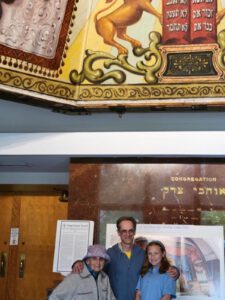
From left, Rosie Pels, her son Robert (Rob) Pels, and her granddaughter Molly Pels pose beneath part of the mural.
Over the next few years, the Jewish population of Burlington continued to grow. My relatives were part of the increased number: Isaac and his wife Sarah had six surviving children; his brothers Aaron and Jacob also had large families. By 1906, there were 162 Jewish families. The area in Burlington, dubbed “Little Jerusalem,” was laid out like the shtetls in the residents’ native Lithuania with houses and kosher bakery, kosher dairy, and a kosher butcher. Two more synagogues were built, including Chai Adam (“Life of Man”), and Ahavath Gerim (“Love of Strangers”). The three synagogues built a Hebrew Free School together in 1910, the Talmud Torah.
In 1910, Chai Adam commissioned a 24-year-old Lithuanian immigrant, theatrical producer, and professional sign painter named Ben Zion Black to create a mural for $200. The completed project had prayer walls and a painted ceiling. The centerpiece is a 25-foot-wide, 12-foot-high three part panel, created in the vibrant and colorful painted art style present in hundreds of Eastern European wooden synagogue interiors in the 18th and 19th centuries. The mural featured the Ten Commandments in its center, golden Lions of Judah on either side, with the artist’s rendering of the sun’s rays adding light. Blue and red curtains and pillars filled the side panels, all representing the artist’s interpretation of the Tent of the Tabernacle as described in the Book of Numbers and the Book of Exodus.
In 1939, amid a decline in Jewish population, Chai Adam synagogue merged with Ohavi Zedek Synagogue. The former Chai Adam building was sold several times after 1952 and later was converted into a carpet store and a warehouse.
Hidden, But Was It Safe?
In 1986, the former Chai Adam synagogue was purchased by a developer with plans to renovate the building into multiple apartments. Recognizing that the future of the mural was in jeopardy, Aaron Goldberg, the archivist for Ohavi Zedek Synagogue and a descendant of Ohavi Zedek’s founding immigrants, persuaded the new owner to seal the mural behind a false wall. Archivist Jeff Potash, Shelburne Museum’s Curator of Collections Richard Kershner, and architect Marcel Beaudin worked with Goldberg, all hoping the mural might be reclaimed at some later date.
Before being hidden, archival quality photographs of the Lost Mural were taken and paid for by Ben Zion Black’s daughters. Much of the painting was destroyed during the renovation but the mural over the ark was covered by a wall. It remained hidden until 2012 when the former Chai Adam building again changed hands.
In 2010, Goldberg partnered with his childhood friend and former Trinity College of Vermont history professor Potash to establish The Lost Mural Project with plans to establish a new home for the Lost Mural and restore the work to its original glory. They reached an agreement with the next owner of the Chai Adam building, the Offenhartz family, that the mural would be uncovered and donated to the Lost Mural Project.This was done with the understanding that the Lost Mural Project would be solely responsible for all costs of stabilizing, moving, cleaning and restoring the Lost Mural.
Moved To Ohavi Zedek
In 2012, after more than two decades, the false wall was removed to examine the Lost Mural. According to one of the curators involved in the project, Black’s creation had sustained extensive damage with “the painting hanging off its plaster base like cornflakes.” Over the next three years, the Lost Mural Project raised substantial funds from individuals, businesses and foundations for the mural’s paint to be stabilized. In May 2015, the mural, encased in steel and weighing approximately 7.500 pounds, was moved to Ohavi Zedek in a marvelous feat of conservators, construction and engineering.
Following the mural’s move, the Lost Mural incorporated, rebranded and tirelessly sought funding for the mural’s cleaning and full restoration with the help of its board and Madeleine May Kunin, the former Vermont governor and U.S. ambassador to Switzerland. By 2022, the organization had raised over one million dollars from local, state, national and international donors.
Funding And Time
During 2021 two conservators hired by The Lost Mural Project began the painstaking task of cleaning the mural. Using the archival photos taken in 1985, they used a gel solvent and cotton swabs to remove the darkened varnish, dirt and grime from the painting’s surface. During the 2022 year, a second team of conservators from Williamstown Art Conservation Center in Massachusetts began the infill, coloring and final restorations. According to Goldberg, the pandemic was in this case a blessing as it gave the team of workers the space and quiet needed to complete the project in the shuttered shul.
“So many things could have gone wrong with the mural, but it survived through fate and circumstance,” says Goldberg. “It’s not just a surviving remnant. It’s a surviving piece with an astonishing history.”
Ohavi Zedek’s Senior Rabbi Amy Small, who saw the 2022 restoration step by step, views the Lost Mural Project as a universal immigrant story. “It’s significant not only to the Jewish community and the descendants of those early settlers of Burlington, but also to other immigrants in the United States, which offered safety for Jewish and other families fleeing from many parts of the world.”
The Friends of the Lost Mural were presented with a 2022 Preservation Award by the Preservation Trust of Vermont. “The Lost Mural…not only exemplifies the rich history of creativity and resilience in Burlington’s Jewish community,” stated Ben Doyle, its president. “ It inspires all of us to remember that the Vermont identity is dynamic and diverse.”
The completed project was unveiled in June 2022. Former Gov.Kunin was honored for her contributions, and a Vermont klezmer band provided the music. Dignitaries both in attendance and on Zoom highlighted the importance of the project. Joshua Perelman, chief curator and director of exhibitions and collections, National Museum Of American Jewish History called the mural “a treasure and also a significant work, both in American Jewish religious life and the world of art in this country.”
Many of the descendants of the original Lithuanian Jews who settled in Burlington over 150 years earlier were present, including descendants of Isaac and Aaron Perelman.
“[The mural] tells us a remarkable story of a thriving Jewish immigrant community from Lithuania and the successful efforts of their descendants to preserve their cultural legacy today,” H.E. Audra Plepyte, the ambassador of Lithuania to the United States stated in remarks shared with Ohavi Zedek. “The Lost Mural is not lost anymore.”
The Lost Mural Project, an independent secular nonprofit, is seeking donations to replicate the green corridors on the original painting that did not survive. Its educational mission is to share the story of the Lost Mural and the lost genre of the East European wooden painted synagogues with people and facilities around the world. Information, including details of the mural’s history, can be found at https://www.lostmural.org/donate. Tours to view the mural may be arranged.
Sources:
Thanks to Aaron Goldberg , Jay Cohen Rob Pels, and Rosie Pels for their contributions to this article.
Rathke, Lisa. “Long-hidden synagogue mural gets rehabbed.” August 17, 2022. AP Wire story; numerous sources.
Sproston, Betty. Burlington Free Press. February 22, 1995.
https://afamilyofstores.com/part-3-family-history-overview/cekiske-synagogue
https://lostmural.squarespace.com/ekik-lithuania
https://www.smithsonianmag.com/smart-news/synagogue-mural-restoration-vermont-apartment-180980614/
rule
Marilyn Shapiro, formerly of Clifton Park, is now a resident of Kissimmee, Fla. A second compilation of her articles printed in
The Jewish World has been published. Tikkun Olam now joins There Goes My Heart. She recently published Fradel’s Story,
a compilation of stories by her mother that she edited. Shapiro’s blog is theregoesmyheart.me.
